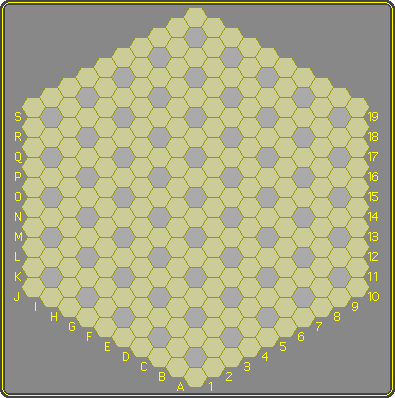The name of the game refers to its goal, making loops, and its procedure, either placing a single man on a vacant cell or moving a 'leaper', which is the top man of a double.
- The Loops 'n Leaps board is a base-10 hexhex grid with 61 'pillars'.
- A 'loop' is closed formation of men of one colour around at least one pillar.
- The goal is to be the first to enclose 3 to 7 pillars with one or more loops.
- The number of pillars needed to win, 3 to 7 inclusive, can be set before the start of the game.
- To spice things up leapers, and only leapers, can capture either by replacement or by the custodian method.
Play Loops 'n Leaps interactively
 | Rules
Loops 'n Leaps is a totally hot game: there's no sense in passing. How to get leapers If a man is placed on a cell that 'sees' friendly pieces along the majority of its cardinal sight lines, then it gets another man on top of it, a 'leaper', indicated by a dot. |
The majority of a cell's sight lines means:
- In three directions for a cell in the inner area.
- In two directions for an edge- or corner cell.
What to do with leapers: direct capture and custodian capture
Leapers may move along straight lines in the cardinal directions, unhindered by friendly cells. They may land on any vacant cell or on the first cell that holds an opposing piece. This piece, regardless of being a single or a double, is then removed from the board and replaced by the capturing leaper. This is called 'direct capture'.
If the leaper lands on a vacant cell and therewith encloses one or more opposing pieces in a straight unbroken line at both ends with its own colour, then these pieces, singles and doubles alike, are removed from the board and replaced by singles of the capturing player. This is called 'custodian capture'.
Completed loops are relatively safe
If a player completes a loop, then all pieces that are part of it are safe from direct capture, but not from custodian capture. A piece is part of a loop if its removal breaks the loop.
The goal
The first player who on his turn completes a loop or loops around at least the number of pillars that is chosen beforehand, 3 to 7 inclusive, wins the game. This may be one loop around the required number of pillars or one loop around each separate pillar or any division in between. If neither player succeeds then, at the end of the game, the player who has more completely surrounded pillars than his opponent wins. If neither has more surrounded pillars than the opponent, then it's a draw.
How I invented ... Loops 'n Leaps
Loops 'n Leaps © MindSports
